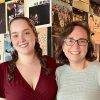You know it’s summer when the Eckerd College Dolphin Project gets underway.
Every summer since 1993, Eckerd students document the dolphin population of Boca Ciega Bay.
The main goal is educational. Students get hands-on training in field research, literature review, scientific writing and analytical thinking.
But the project also gathers valuable information about bottlenose dolphins and the ecology of Boca Ciega Bay and surrounding waters, including the sounds dolphins make beneath the surface.
“It’s been a very successful program,’’ says Associate Professor of Biology and Marine Science Shannon Gowans. “We have lots of people now working in the field.” The hands-on experience students receive gives them an advantage when applying for jobs and graduate school, she says. More than 20 senior theses have been done through the dolphin project.
Gowans and her students use software developed at Eckerd and funded by a NationalScience Foundation Grant to identify dolphins through photographs of the unique markings on their dorsal fins. The DARWIN software — the acronym stands for Digital Analysis and Recognition of Whale Images on the Network — was developed by EC Computer Science students and Professors Kelly Debure and John Stewman.
The software is distributed free over the Internet and is now used by scientists around the world, Debure says. “The students have always believed that it was really important that the code that we developed to be a
vailable open source,’’ she explains. “Otherwise everyone is reinventing the wheel. The only way we can move research forward in a positive way is to work together as an international coalition.’’
The database has grown to 900 different dolphins documented over the years. Most come and go, but Gowans estimates that 85 to 100 live year-round in Boca Ciega Bay.
Gowans, who took over the project when she joined Eckerd in 2004, has spent so much time studying the Boca Ciega dolphins she can identify many of them by sight. “I’ve been doing this a while,’’ she says as she pilots a 19-ft. boat with three of her student researchers one recent morning.
“Dolphin straight ahead!” Gowans announces at one point, and the students — all three are rising sophomores — move into position. On this trip, psychology major Carly Olson, 19, of Denver takes photos; marine science major Emily Sullivan, 18, monitors their position with a hand-held GPS device; and Brittany Evans, 18, takes notes. They will all share the tasks, shifting from camera to GPS and note-taking. Along with human development major Nikki Szlamnik. They are paid for their work and live in the dorms for much of the summer.
Gowans recognizes the dolphin immediately. “That was BTLE,” she says. “Write that down.”
Photographing the dorsal fins isn’t easy, even with a telescopic lens. The dolphins move quickly and in unexpected ways, and the best photos for analysis are taken when a dolphin is parallel with the boat.
On some trips, they collect dolphin sounds using a special recording device they pull behind the boat below the surface. Dolphins emit myriad sounds to communicate with each other. Last year, a student used the recordings to show how the sounds change when boats go by.
Dolphins are endlessly fascinating creatures, Gowans says, even for non-scientists. They are “highly intelligent, highly social and yet so different from humans,’’ she explains. “They can do all kinds of incredible things.’’
Suddenly, one of the dolphins does just that. “Oh!’’ Gowans says excitedly. “That was fish-whacking!’’ That’s when a dolphin uses its tail to flip a fish high into the air. When it hits the water, it is momentarily stunned, giving the dolphin a chance gobble it up.
“If you can get that, Carly,” Gowans says, “that would be fantastic.’’ The dolphin obliges and fish-whacks again.
The field research can be fun and exciting, but it’s only a small part of the work. Gowans estimates that three to four hours are spent in the lab analyzing the research for every hour spent in the field. Simply reviewing the photos is laborious, even with the aid of the DARWIN software. The team will routinely take 300 to 500 photos during a single outing, and Gowans tries to be in the field two or three times a week. “I’ve had days of 1,200 to 1,400 photos,’’ she says.
Cataloguing all those photos takes time, especially when new dolphins are found. Determining if a dolphin is new requires going through 881 dolphins in the database — a painstaking process.
It’s not like getting a fingerprint match on CSI. The DARWIN software “gives you a ranked order of who it thinks the correct individual animal is and then the biologist has to go through the ranked order list to see which one it is.”
But that’s one of the important lessons for student researchers: It’s not all glitz and glamour.












